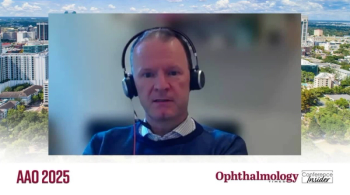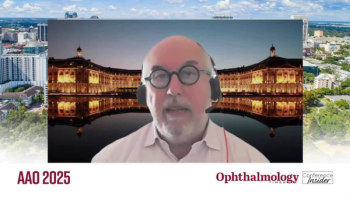
Small aperture corneal inlay and presbyopia
Procedure may increase near and intermediation vision without compromising stereopsis
Take-home
An investigational small aperture corneal inlay (Karma, AcuFocus) may improve near and intermediation vision in patients with presbyopia without compromising stereopsis, like other current treatment options, such as LASIK monovision or contact lens monovision.
By Nancy Groves; Reviewed by Jay Stuart Pepose, MD, PhD
St. Louis-Findings from several studies of the
Recent studies, Dr. Pepose said, found that binocular and monocular mesopic and photopic contrast scores showed a reduction-although results remained well within normal limits-and that stereopsis scores are unaffected by the presence of the inlay. In addition, patients reported that they could easily perform near, intermediate, and distance tasks without glasses in different lighting conditions and had a low incidence of visual symptoms 24 months after implantation.
Dr. Pepose, is the founder and medical director of the Pepose Vision Institute, St. Louis. He also serves as professor of clinical ophthalmology at Washington University School of Medince and Barnes-Jewish Hospital, St. Louis.
The inlay is designed to improve functional near and intermediate vision, as well as reducing dependence on reading glasses while maintaining distance vision. It is 3.8 mm in diameter and works by blocking unfocused light and expanding depth of field through its fixed 1.6 -mm central aperture.
Made of polyvinylidene fluoride-a biocompatible material commonly used in intraocular lens haptics-the inlay is 5 mµ thick. It received CE Mark approval for use in Europe in 2005, and a pre-market approval application was submitted to the FDA in December 2012.
Examining the study
Dr. Pepose said the objective and subjective results were from a prospective, non-randomized clinical trial that was conducted at 24 sites in the United States, Europe, and the Asia-Pacific region. The study enrolled and implanted 507 subjects who were naturally occurring presbyopic emmetropes aged 45 to 60 years old with a spherical equivalent between +0.50 and -0.75D. Uncorrected near visual acuity was worse than 20/40 and better than 20/100 preoperatively.
Binocular photopic contrast sensitivity remained within normal limits at 24 months post-operatively, although there was a statistically significant decrease from preoperative levels (p < 0.001) at certain spatial frequencies.
Similarly, monocular and binocular mesopic contrast sensitivity were also within the normal range at 24 months.
Stereopsis was evaluated pre-operatively and at 6 months post-operatively in a sub study of 60 patients treated by Phillip C. Hoopes, MD, in Salt Lake City, Utah.
The difference in mean pre-operative and post-operative distance stereoacuity was not statistically significant (36.1 ± 31.3 vs. 35.5 ± 34.7 arc sec).
Dr. Pepose compared treatment with the Kamra inlay to alternative procedures for presbyopic vision correction.
Further investigations
Monovision with LASIK resulted in a 2.75-fold increase in arc seconds (p < 0.05) between pre-operative and post-operative examinations (165.55 ± 138.25 vs. 451.74 ± 286.97) in a study of 25 patients. These findings were reported by Alarcon et al. (J Cataract Refract Surg 2011;37:1629-1635).
In a study of increasing amounts of contact lens monovision, statistically significant changes from baseline (32 ± 33 arc sec) occurred at all levels (+0.75 D: 44 ± 38, 1.38-fold increase; +1.5 D, 77 ± 76, 2.41-fold increase; +2.5 D, 182 ± 142, 5.7-fold increase. p < 0.01).
This prospective study was performed by Durrie (Trans Am Ophthalmol Soc 2006:104:366-401).
“The Kamra inlay is in marked contrast to the findings of monovision’s loss of stereopsis after pseudophakic LASIK and contact lens monovision,” Dr. Pepose said.
He also reported the results for near vision tasks, as data was obtained from a questionnaire in which patients were asked how easy it was to perform a series of near vision tasks with both eyes without their glasses.
The scale ranged from 1, “not easy at all,” to 7, “very easy.” At 24 months, statistically significant improvement was seen in mean scores for performing near tasks in both dim and bright light conditions (p < 0.001). These included intermediate vision tasks such as viewing a computer and near tasks such as reading a book or newspaper.
Mean scores for viewing a computer improved significantly from 2.74 ± 1.42 pre-operatively to 5.09 ± 1.72 at 24 months, and mean scores for reading a book improved significantly from 1.73 ± 1.04 to 4.66 ±` 1.76 over the same time period.
“This is impressive, especially given that the mean MRSE (mean refraction spherical equivalent) in the inlay-implanted eye was +0.18 D ± 0.79, and we have learned commercially that having a small amount of myopia further enhances near and intermediate vision,” Dr. Pepose said. “I think we shouldn’t minimize the need of good intermediate vision for our patients who now are using many handheld devices.”
The ease of distance task performance remained stable at 24 months post-operatively, and there was little or no change in patients’ ranking of the ease of performing the tasks (p = 0.016).
Patients reported a very low incidence of visual symptoms post-operatively, such as glare, halo, and night vision problems. All mean symptom scores were reported between 0.2 and 1.6 on a scale of 1 to 7 at 24 months. There was no indication of the photopsia sometimes associated with multifocal lens implants, Dr. Pepose said.
Jay Stuart Pepose, MD, PhD
Dr. Pepose is a consultant for AcuFocus.
Newsletter
Don’t miss out—get Ophthalmology Times updates on the latest clinical advancements and expert interviews, straight to your inbox.





















































.png)


